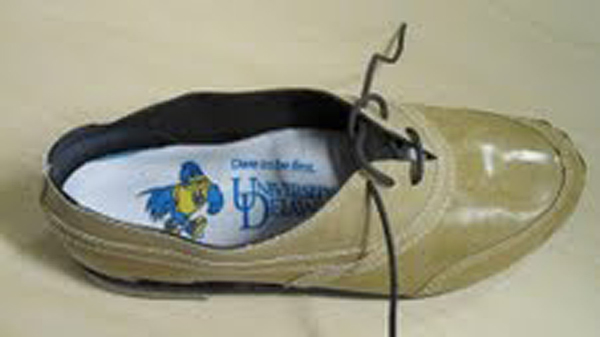
Green in fashion
Fashion, chemical engineering students work together on 'eco-clothes'
1:23 p.m., March 8, 2011----In a unique partnership between the departments of Fashion and Apparel Studies and Chemical Engineering at the University of Delaware, faculty and students are designing and developing apparel and footwear using renewable sources and waste, with hopes that their end products will be fashionable, affordable and environmentally sustainable.
The undergraduate research team includes Paula Bonanno, Jillian Kramer and Stacey Lipschitz from fashion and Quan Dan from chemical engineering. Their project aims to solve many of the environmental problems currently plaguing the fashion industry, from a growing dependence on nonrenewable petroleum-derived materials to carbon emissions associated with traditional textiles such as leather, PVC and wool.
Research Stories
Chronic wounds
Prof. Heck's legacy
“We're combining science and engineering with merchandising and design to bring consumers tangible, usable, wearable products that promote sustainability,” says Huantian Cao, associate professor and an expert in sustainable apparel design and production, who is leading the team with his colleague, Richard Wool, professor of chemical engineering.
Wool directs the Affordable Composites from Renewable Sources program. His research centers on the use of plant oil and chicken feathers in new composite bio-based materials.
As co-principal investigator on the project, Wool is working with his chemical engineering students to develop thermoset resins, polyurethane foams, adhesives and nonwoven insulated materials from plant oils and chicken feathers that the fashion design and merchandising students can then use to create an environmentally-sustainable coat and pair of shoes.
Their design of the coat, for instance, uses bio-based regenerated fabrics such as wool and cotton for the shell and lining, chicken feather fibers for the insulation, and chicken feather composite for buttons.
While the team is in the beginning stages of designing the jacket, they have already developed an initial prototype for their shoe with help from Reebok. Cao contacted the company late last year for support on making the prototype after local shoe repair shops were unable to assist his request.
Reebok creates prototype of shoe
Paula Bonanno, a senior fashion merchandising major, and Stacey Lipschitz, a junior apparel design major, who are both in the University Honors Program, traveled to Reebok's headquarters in Canton, Mass., last week, where they met and worked alongside pattern engineers, sample makers and sewing technicians to turn their initial sketches into an actual, trendy, “Oxford-style” shoe.
The process took less than a day, and the students were able to see “how the shoe comes to life and what all you have to consider when designing it, from the shape and molding of each individual piece to how to transfer the 2D pieces into a 3D shoe,” explains Bonanno.
The end product is composed of nearly 90 percent of the sustainable materials developed by the ACRES team, but the prototype still needs some work -- the material is slightly ripped around the toe and the cotton coated with soybean-based resin that comprises the outer layer of the shoe doesn't stretch, which means the students will need to send a bigger sample for the second go-around.
The research team plans to send materials back to Reebok by the end of the month and hopes to have the second prototype back by April.
“In many ways, this is still an experimental stage,” says Lipschitz. “How will the chicken feather settle in the coat? How will the strong and flexible resins work? We're still learning.”
One of the most successful discoveries to date has been the combination of chicken feather fibers and soybean polymers used on the heel of the shoe.
“It's beautiful -- it looks exactly like leather,” Bonanno says, adding that one of the main goals of the project is to illustrate how sustainable materials can be used in fashion.
People, prosperity, and the planet
The project is funded by a $10,000 grant from the U.S. Environmental Protection Agency's P3 Program, a national student design competition for sustainability focusing on people, prosperity, and the planet.
“Removing leather tanning and PVC synthesis from apparel and footwear material production will reduce environmental pollution and improve the health of industry employees and surrounding communities,” says Cao, who will be competing in P3 for the fifth time this year.
“Carbon emissions from livestock will be reduced with less leather in the garments,” he adds, “and industry will save costs by using renewable sources and waste as raw materials, leading to more affordable products for consumers in the long term.”
Cao and his research team will display their eco-apparel on April 16-17 on the National Mall in Washington, D.C., alongside the 54 other teams in the P3 competition.
Article by Artika Rangan









